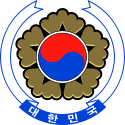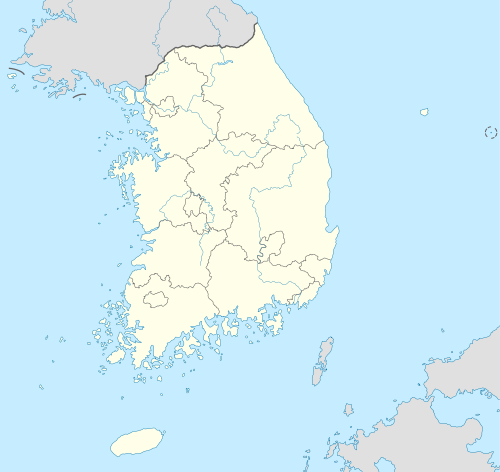- Administrative divisions of South Korea
-
Administrative divisions
of South KoreaProvincial level Province
(道 도 do)Special Self-Governing Province
(特別自治道 특별자치도 teukbyeoljachi-do)Special city
(特別市 특별시 teukbyeol-si)Metropolitan city
(廣域市 광역시 gwangyeok-si)Municipal level City
(市 시 si)County
(郡 군 gun)District
(區 구 gu)Town
(邑 읍 eup)Township
(面 면 myeon)Neighbourhood
(洞 동 dong)Ri
(里 리 ri)South Korea 
This article is part of the series:
Politics and government of
South KoreaGovernment National Assembly
political parties
GNP · DEP · LFP · FHA · DLP · PPP · NPPElections Presidential elections
1997 • 2002 • 2007Legislative elections
2000 • 2004 • 2008Local elections
2002 • 2006 • 2010By-elections
2011Related topics Korean reunification
Sunshine Policy
Administrative divisions
Human rights
Foreign relations
South Korea is divided into 8 provinces (do), 1 special autonomous province (teukbyeol jachido), 6 metropolitan cities (gwangyeoksi), and 1 special city (teukbyeolsi). These are further subdivided into a variety of smaller entities, including cities (si), counties (gun), districts (gu), towns (eup), townships (myeon), neighborhoods (dong) and villages (ri), as explained below.
Note on translation: although the terms "Special City", "Metropolitan City", "Province", and "City" are commonly used on English-language government websites, the other translations — "county", "town", "district", etc. — are not official translations, and are only intended to serve as useful illustrations of each entity's meaning. The northwestern islands of Yeonpyeong Island, Baengnyeong Island, Daecheong Island, and the much smaller Socheong Island are part of Ongjin.
Contents
Local government
Korean terms appear in their official Revised Romanization of Korean spelling.
Level Name Types 1 Provincial level - Provinces (도; 道; do) (8)
- Special Self-Governing Province (특별 자치도; 特別自治道; teukbyeoljachi-do) (1)
- Special city (특별시; 特別市; teukbyeol-si) (1)
- Metropolitan cities (광역시; 廣域市; gwangyeok-si) (6)
2 Municipal level - Cities (시; 市; si) (77)
- Counties (군; 郡; gun) (85)
- Districts (구; 區; gu)
- Towns (읍; 邑; eup)
- Townships (면; 面; myeon)
- Neighborhoods (동; 洞; dong)
- Villages (리; 里; ri)
Provincial level divisions
Main article: Provinces of South KoreaProvincial level divisions are the first-level division within South Korea and it is divided into four groups: provinces, special self-governing province, special city, and metropolitan cities.
Municipal level divisions
Si (City)
Further information: List of cities in South KoreaA si (시, 市) is one of the divisions of a province, along with gun. Cities have a population of at least 150,000; once a county (gun) attains that population, it becomes a city (Gijang county in Busan is an exception). Cities with a population of over 500,000 (such as Suwon, Cheongju, and Jeonju) are divided into districts (gu); Hwaseong and Namyangju are noticeable exceptions to this rule. Gus are then further divided into neighborhoods (dong); cities with a population of less than 500,000 do not have wards – these cities are directly divided into neighborhoods (dong).
Gun (County)
Further information: List of counties in South KoreaA gun (군; 郡) is one of the divisions of a province (along with si), and of the metropolitan cities of Busan, Daegu, Incheon and Ulsan (along with gu). A gun has a population of less than 150,000 (more than that would make it a city or si), is less densely populated than a gu, and is more rural in character than either of the other 2 divisions. Gun are comparable to British non-metropolitan districts. Counties are divided into towns (eup) and districts (myeon).
Gu (District)
A gu (구; 區) is equivalent to district in the West. Most cities are divided into gus, though the metropolitan cities of Busan, Daegu, Incheon and Ulsan contain guns as well. Gus are similar to boroughs in some Western countries, and a gu office handles many of the functions that would be handled by the city in other jurisdictions. Gus are divided into neighborhoods (dong).
Eup (Town)
Main article: Eup (administrative division)An eup (읍; 邑) is similar to the unit of town. Along with myeon, an eup is one of the divisions of a county (gun), and of some cities (si) with a population of less than 500,000. The main town or towns in a county—or the secondary town or towns within a city's territory—are designated as eups. Towns are subdivided into villages (ri). In order to form an eup, the minimum population required is 20,000.
Myeon (Township)
Main article: Myeon (administrative division)A myeon (면; 面) is one of the divisions – along with eup – of a county (gun) and some cities (si) of fewer than 500,000 population. Myeons have smaller populations than eups and represent the rural areas of a county or city. Myeons are subdivided into villages (ri). The minimum population limit is 6,000.
Dong (Neighborhood)
Main article: Dong (administrative division)A dong (동; 洞) is the primary division of districts (gu), and of those cities (si) which are not divided into districts. The dong is the smallest level of urban government to have its own office and staff. In some cases, a single legal dong is divided into several administrative dong. Administrative dongs are usually distinguished from one another by number (as in the case of Myeongjang 1-dong and Myeongjang 2-dong). In such cases, each administrative dong has its own office and staff.
The primary division of a dong is the tong (통; 統), but divisions at this level and below are seldom used in daily life. Some populous dong are subdivided into ga (가; 街), which are not a separate level of government, but only exist for use in addresses. Many major thoroughfares in Seoul, Suwon, and other cities are also subdivided into ga.
Ri (Village)
Main article: Ri (administrative division)A ri (리; 里) is the only division of towns (eup) and districts (myeon). The ri is the smallest level of rural government to contain any significant number of people.
History
Although the details of local administration have changed dramatically over time, the basic outline of the current three-tiered system was implemented under the reign of Gojong in 1895. A similar system also remains in use in North Korea.
See also
- Administrative divisions of North Korea
- ISO 3166-2:KR, ISO codes for cities and provinces in South Korea
- List of cities in South Korea
- List of South Korean regions by GDP
- Provinces of Korea
- Special cities of Korea
References
External links
 Regions and administrative divisions of South Korea
Regions and administrative divisions of South KoreaRegions Provinces Special self-governing province Special city Metropolitan cities Proposed special autonomous city Categories:- Subdivisions of South Korea
- Country subdivisions of Asia
- Lists of country subdivisions
Wikimedia Foundation. 2010.


